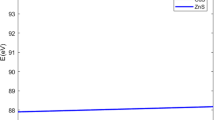Abstract
We study the drag resistivity numerically for charge carriers in a specially separated electron-electron (e-e) bilayer system for both the symmetric and asymmetric case in weak interaction and Boltzmann regime. Interaction in Coulomb drag effect is based on Coulomb interaction in a specially separated bilayer systems. Random phase approximation (RPA) method is used to find the drag resistivity. Simply RPA method is a reliable method for high-density regime where exchange and correlation effects do not impact too much. On lowering the density, the exchange and correlation effects are significant which are included by suggesting the local field correction (LFC) in effective interlayer interactions. The drag resistivity is noticed improvement on employing the LFC. Impact of exchange and correlation based LFC increase on increasing the temperature and decreasing the concentration. Predictable behaviour is shown by the dependency of drag resistivity on temperature, density, interlayer spacing, and dielectric constant.





Similar content being viewed by others
Data availability statement
The data that support the findings of this study are available from the corresponding author upon reasonable request.
References
R.E.V. Profumo, M. Polini, R. Asgari, R. Fazio, A.H. MacDonald, Electron-electron interactions in decoupled graphene layers. Phys. Rev. B (2010). https://doi.org/10.1103/PhysRevB.82.085443
B. Scharf, A. Matos-Abiague, Coulomb drag between massless and massive fermions. Phys. Rev. B (2012). https://doi.org/10.1103/PhysRevB.86.115425
A. Gamucci, D. Spirito, M. Carrega, B. Karmakar, A. Lombardo, M. Bruna, L.N. Pfeiffer, K.W. West, A.C. Ferrari, M. Polini, V. Pellegrini, Anomalous low-temperature Coulomb drag in graphene-GaAs heterostructures. Nat. Commun. 5(1), 5824 (2014). https://doi.org/10.1038/ncomms6824
P. Simonet, S. Hennel, H. Overweg, R. Steinacher, M. Eich, R. Pisoni, Y. Lee, P. Märki, T. Ihn, K. Ensslin, M. Beck, J. Faist, Anomalous Coulomb drag between bilayer graphene and a GaAs electron gas. New J. Phys. (2017). https://doi.org/10.1088/1367-2630/aa887e
S.K. Upadhyay, L.K. Saini, Coulomb drag study in electron-electron bilayer system with a dielectric medium. Phys. E: Low-dimens. Syst. Nanostruct. 124, 114350 (2020)
S.K. Upadhyay, L.K. Saini, Coulomb Drag of Electron-Electron Interactions in GaAs Bilayer with a Non Homogeneous Dielectric Background. Adv. Mater. Lett. 11(7), 20071539 (2020). https://doi.org/10.5185/amlett.2020.071539. https://www.vbripress.com/aml/articles/details/1532
S.K. Upadhyay, L.K. Saini, Drag resistivity in InAs/GaAs and InAs/GaSb bilayer due to electron-electron interactions. AIP Conference Proceedings 2220(1) (2020). https://doi.org/10.1063/5.0002594
L.K. Saini, S.K. Upadhyay, B.P. Bahuguna, Investigations of optical and thermoelectric response of GaBi monolayer. AIP Conference Proceedings 2220(1) (2020). https://doi.org/10.1063/5.0002593
S.K. Upadhyay, L. Saini, Physica E: Low-dimensional Systems and Nanostructures p. 114484 (2020). https://doi.org/10.1016/j.physe.2020.114484. http://www.sciencedirect.com/science/article/pii/S1386947720315526
P.J. Price, Hot electron effects in heterolayers. Phys. B+C 117–118, 750 (1983). https://doi.org/10.1016/0378-4363(83)90642-3
A. Yurtsever, V. Moldoveanu, B. Tanatar, Many-body effects in the Coulomb drag between low density electron layers. Solid State Commun. 125(11), 575 (2003). https://doi.org/10.1016/S0038-1098(03)00081-4
R. Asgari, B. Tanatar, B. Davoudi, Comparative study of screened interlayer interactions in the Coulomb drag effect in bilayer electron systems. Phys. Rev. B (2008). https://doi.org/10.1103/PhysRevB.77.115301
P. Arora, G. Singh, R.K. Moudgil, Dynamic correlation effects on drag resistivity of a symmetric electronâEUR’’electron bilayer. Eur. Phys. J. B 91(8), 181 (2018). https://doi.org/10.1140/epjb/e2018-90127-4
D.Y.H. Ho, I. Yudhistira, B.Y.K. Hu, S. Adam, Theory of Coulomb drag in spatially inhomogeneous 2D materials. Commun. Phys. 1(1), 41 (2018). https://doi.org/10.1038/s42005-018-0039-y
M. Kellogg, I.B. Spielman, J.P. Eisenstein, L.N. Pfeiffer, K.W. West, Evidence for 2kF electron-electron scattering processes in Coulomb drag. Phys. Rev. Lett. (2002). https://doi.org/10.1103/PhysRevLett.88.126804
A.S. Price, A.K. Savchenko, B.N. Narozhny, G. Allison, D.A. Ritchie, Giant Fluctuations of Coulomb Drag in a Bilayer System. Science 316(5821), 99 (2007). https://doi.org/10.1126/science.1139227. http://science.sciencemag.org/content/316/5821/99
B. Zheng, A.F. Croxall, J. Waldie, K. Das Gupta, F. Sfigakis, I. Farrer, H.E. Beere, D.A. Ritchie, Switching between attractive and repulsive Coulomb-interaction-mediated drag in an ambipolar GaAs/AlGaAs bilayer device. Appl. Phys. Lett. 108(6), 062102 (2016). https://doi.org/10.1063/1.4941760
T. Vazifehshenas, T. Salavati-fard, Inelastic Coulomb scattering rate within the finite-temperature Hubbard approximation. Physica Scripta (2010). https://doi.org/10.1088/0031-8949/81/02/025701
T. Salavati-fard, T. Vazifehshenas, Local field correction effect on inelastic Coulomb scattering lifetime of two-dimensional quasiparticles at low temperatures. Physica B: Condensed Matter 406(10), 1883 (2011). https://doi.org/10.1016/j.physb.2011.02.047. http://www.sciencedirect.com/science/article/pii/S0921452611001694
G. Giuliani, G. Vignale, Quantum Theory of the Electron Liquid (Cambridge University Press, Cambridge, 2005). https://doi.org/10.1017/CBO9780511619915
B. Amorim, N.M.R. Peres, On Coulomb drag in double layer systems. J. Phys.: Condens. Matter (2012). https://doi.org/10.1088/0953-8984/24/33/335602
M. Carrega, T. Tudorovskiy, A. Principi, M.I. Katsnelson, M. Polini, Theory of Coulomb drag for massless Dirac fermions. New J. Phys. (2012). https://doi.org/10.1088/1367-2630/14/6/063033
N.V. Men, D.T.K. Phuong, Plasmon modes in bilayer-graphene-GaAs heterostructures including layer-thickness and exchange-correlation effects. Int. J. Modern Phys. B 32(23), 1850256 (2018). https://doi.org/10.1142/S0217979218502569
N.V. Men, N.Q. Khanh, Plasmon modes in graphene-GaAs heterostructures. Physics Letters A 381(44), 3779 (2017). https://doi.org/10.1016/j.physleta.2017.09.047. http://www.sciencedirect.com/science/article/pii/S0375960117309441
R. Pillarisetty, H. Noh, D.C. Tsui, E.P. De Poortere, E. Tutuc, M. Shayegan, Frictional drag between two dilute two-dimensional hole layers. Phys. Rev. Lett. (2002). https://doi.org/10.1103/PhysRevLett.89.016805
R. Pillarisetty, H. Noh, E. Tutuc, E.P. De Poortere, K. Lai, D.C. Tsui, M. Shayegan, Coulomb drag near the metal-insulator transition in two dimensions. Phys. Rev. B (2005). https://doi.org/10.1103/PhysRevB.71.115307
Acknowledgements
We thank Dr. K. N. Pathak for very useful, helpful and stimulating discussions. My research work in SVNIT was supported by the Indian Ministry of Education through the grant of CSIR and MHRD. We acknowledge the CSIR under the JRF and SRF fellowship, file no. 09/1007(0004)/2018-EMR-I for financial support in our research.
Author information
Authors and Affiliations
Contributions
SKU helped in conceptualization, methodology, validation, investigation, writing–original draft, visualization; LKS contributed to supervision.
Corresponding author
Ethics declarations
Conflict of interest
The authors wish to confirm that there are no known conflicts of interest associated with this publication and there has been no significant financial support for this work that could have influenced its outcome. We also confirm that the manuscript has been read and approved by all named authors.
Additional information
Publisher's Note
Springer Nature remains neutral with regard to jurisdictional claims in published maps and institutional affiliations.
Rights and permissions
About this article
Cite this article
Upadhyay, S.K., Saini, L.K. Study of drag resistivity in dielectric medium with the correlations effect. Appl. Phys. A 127, 276 (2021). https://doi.org/10.1007/s00339-021-04422-y
Received:
Accepted:
Published:
DOI: https://doi.org/10.1007/s00339-021-04422-y




